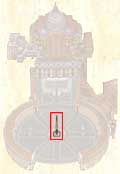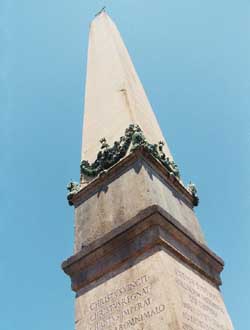| Grottoes
Vatican City Colonnade Saints Floorplan #2 |
| Altars
Monuments The History |
|
Related Items |
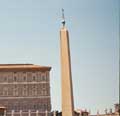 |
 |
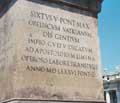 |
 |
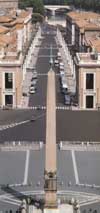 |
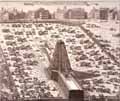 |
From:
'Seminarians Guide'
Obelisk is from obeliscus - "in the shape of a spear". For pagans, the
obelisk was a solar symbol that represented a vital flow between heaven
and earth, a way of communicating to the divine.
As a pagan monument in the greatest Christian square, it is a symbol of humanity reaching out to Christ. Originally inscribed to "Divine Augustus" and "Divine Tiberius" and now dedicated to the Holy Cross - "Christus Vincit, Christus Regnat, Christus Imperat. Christus ab omni malo plebem suam defendat." It is topped by a bronze cross containing a fragment of the true Cross.
From 'St. Peter's
- Guide to the Basilica and Square'
A large pink granite obelisk can be admired in the center of the square.
It was hewn from a single block and stands 25.31 m. high on a base 8.25
m. wide. The obelisk which comes from Heliopolis, Egypt, where it was
built by the Pharaoh Mencares in 1835 BC in honor of the sun, was brought
to Rome in 37 BC by the Emperor Caligula (37-41) and erected in the circus
he built. Here it was silent witness of the martyrdom of St. Peter and
of many other Christians. In 1586 Sixtus V had it moved to the center
of St. Peter's Square. This operation, which required hundreds of workmen,
was directed by Domenico Fontana with the help of his brother, Giovanni,
and took four months. It was erected on September 10, 1586 by 900 men
using 140 horses and 44 winches.
From 'St. Peter's
Basilica - A Virtual Tour' by Our
Sunday Visitor
Another interesting illustration of the obelisk is contained in the fresco
"Coronation of Pope Sixtus V" in 1585, in the Sistine Hall of the Vatican
Library. In it, as in other engravings, the obelisk is still standing
to the left of the Basilica.
An anonymous painting in the Museum of Rome, illustrating the Corpus Christi Procession, shows St. Peter's Square with the obelisk already in place, before the colonnades were built. This monolithic obelisk in red granite, 25 meters high and weighing approximately 1 million pounds, had been taken from the city of Alexandria by Caligula (37-41 A.D.) to be placed on the spine of the circus later to be known as Nero's, situated to the left of the Old Basilica.
Given the difficulty of moving it, several projects were considered until Sixtus V entrusted the job to his favorite architect, Domenico Fontana, who presented a wooden model, containing a lead grid, a replica of the obelisk, which could be easily lowered and raised. His project met with the Pope's approval and on April 30, 1586, transport was begun, after a solid foundation had been built to support the obelisk in the center of the square but not on the median axis of the façade of the Basilica.
The operation, which is illustrated by several engravings, was carried out using hemp ropes and iron bars weighing 40,000 pounds, plus 900 men and 72 horses, and was completed on Sept. 10 of the same year.
There is no truth in the story of "water on the ropes" which is supposed to have occurred during the raising of the obelisk, the work on which was, however, suspended during the summer. On the top, in place of the golden urn, said to contain the ashes of Caesar, was placed a bronze emblem of Pope Sixtus containing a relic of the cross. At the base are four bronze lions supported by a high pedestal.
From: 'Guide to St. Peter's Basilica' © 2003
It is a red granite unique block 25.31m high, on a 8.25m base, weighing
about 330 tons. It is the second highest obelisk in Rome, after the Lateran
one, and the only one devoid of hieroglyphics, but with Latin inscriptions.
Pliny the Elder wrote about it in his Naturalis Historia (1st century
AD). It was brought from Egypt by Caligula, on a ship filled with lentils
to prevent any damage and raised in the Spina of his Circus, then called
Nero's Circus. After the voyage the ship was filled with pozzolana and
sunk so as to be used as the base for the left pier of Claudius' harbour,
at the mouth of the Tiber.
Sixtus V ordered it moved to the center of the square, putting Domenico Fontana in charge of the operation. Solid foundations were built to support the heavy structure and on April 30, 1586 the operations started - 907 men, 75 horses and 40 cranes were required. The obelisk was raised into position on September 10, six days later it was placed on the base and on September 26 it was blessed and consecrated.
The inscriptions on the north and south sides of the base have texts written by Cardinal Silvio Antoniani as a memorial to the moving of the obelisk. The east and west sides have exorcist formulas.
